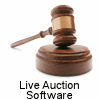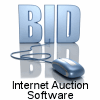Frequently Asked Questions - Auction Flex
Is Auction Flex only for live auctions or is it an online eBay-style auction site?
Our software is for managing live and online auctions. We also provide a web service (HiBid) that allows you to take internet absentee bids on your upcoming auctions, conduct internet-only auctions, or take live internet bids via our webcast. Our internet bidding platform is optional and is not required to use the Auction Flex software.
Is Auction Flex sold by module?
No. We feel you are entitled to a full-featured product at a reasonable price. Even if you don't use all of our software's capabilities, you still get your money's worth. And what's better is that the capability is waiting at your fingertips should you decide to use it in the future.
Does Auction Flex support multiple users?
Yes. Auction Flex works in both peer-to-peer and client/server networking environments.
A peer-to-peer network is a type of network in which each workstation has equivalent capabilities and responsibilities, though all data is stored on the main computer. This type of network is generally setup with 2, 3, or 4 computers where every computer will be running Auction Flex.
With 5 of more computers, we generally recommend a client/server network architecture. In this setup a dedicated server hosts the data for all the other computers (clients). Servers also generally have a Raid1 (mirrored) hard drive array, which provides an additional layer of fault tolerance. With Raid 1, if a single hard drive on the server fails, the other hard drive immediately takes over without any down time.
Peer-to-peer networks are generally simpler, but they usually do not offer the same performance under heavy loads.
Does Auction Flex offer wireless clerking?
Yes, we offer wireless clerking via RF Modems, Auction Flex Mobile using WiFi, or a handheld terminal.
Wireless clerking on a regular computer via RF modems is the best long-range solution; it has greater range and greater stability than WiFi.
To clerk over WiFi, you can use Auction Flex Mobile. Keep in mind that Auction Flex Mobile works on tablets, smartphones, and regular computers (just open a browser).
What are your suggested minimum requirements?
Windows
98/ME/NT/2000/XP/Vista/Windows 7/Windows 8/Windows 10
Processor: 400Mhz for 98/ME, 700Mhz Processor for NT/2000, 1Ghz for
XP/Vista/Windows 7/Windows 8/Windows 10
Memory: 64MB Ram for 98/ME, 128MB for NT/2000, 256MB for XP, 2GB for
Vista/Windows 7/Windows 8/Windows 10
Screen Resolution: 1024x768 (will work on 1024x600 netbooks and clerking
screen will work on resolution as low as 800x600)
Hard Drive: 150MB of space for the program and data. More if you plan to use
Auction Flex imaging capabilities.
Can Auction Flex run on a Mac?
Auction Flex is Windows-based. However, if you can run parallels or Boot camp with Windows, you should be able to use Auction Flex.
Auction Flex in the Cloud can be run on Macintosh computers.
What type of printer do you recommend?
The printer of choice is definitely a middle-of-the-road laser if portability and price are of no concern. Brother has come out with some very affordable black-and-white laser printers like the HL2230 which currently retail for around $80. Just keep in mind that the faster ppm (page per minute) rating, the less you'll be waiting on the printer and the quicker your check-out line will run.
Inkjet printers are a good option when price or portability are of concern. Look for a high page per minute rate (14 or more ppm) for black printouts. The downside to inkjets is that the replacement cartridges are expensive and that they generally use the computer's processing resources to print.
Dot-matrix printers are very often too slow for normal reporting; however, Auction Flex does have a specialized invoice/receipt so that dot-matrix printers can be used for buyer check-out, which permits the continued use of existing equipment and multi-part paper.
Tutorial Videos
For a comprehensive look at how Auction Flex works, Click Here for access to a variety of tutorial videos to show everything from a Quick Demo to Detailed Cataloging.


